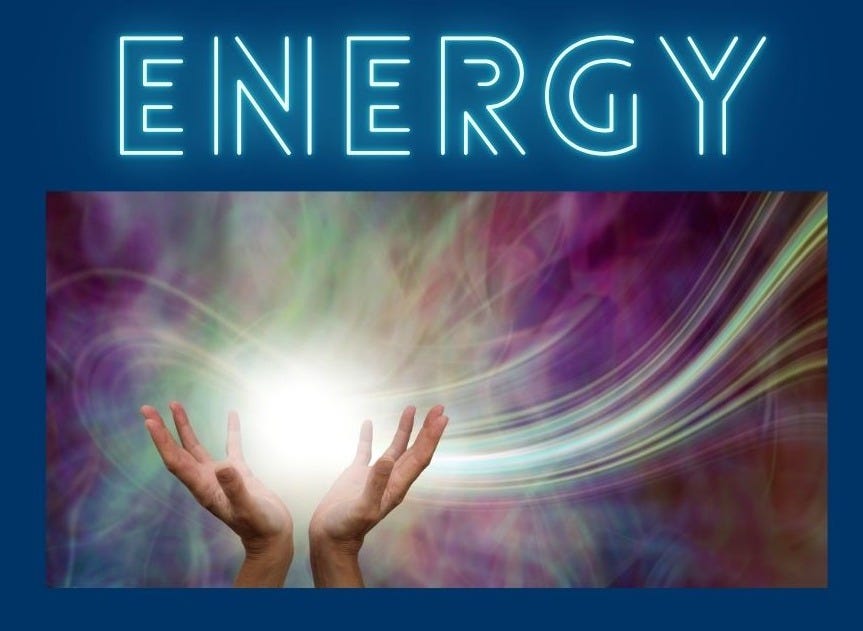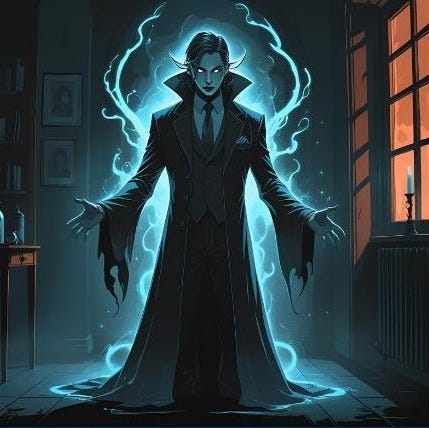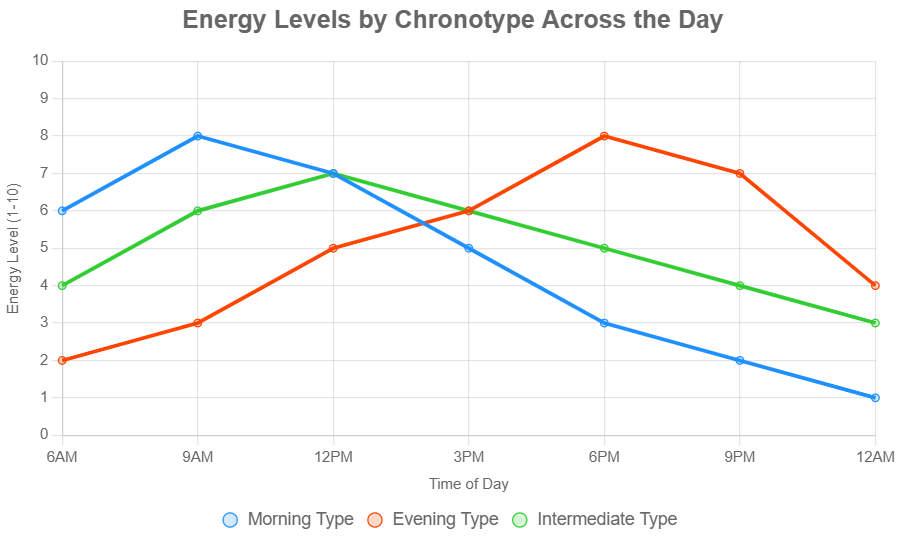Has your energy shifted as you’ve gotten older? You may find yourself waking earlier and crashing by 9 p.m., yet still pushing through late nights out of habit.
If so, you might be fighting your body’s natural rhythms—specifically your chronotype (what I call your energy personality). Your chronotype is your unique pattern of alertness, sleepiness, and productivity, shaped by your body’s internal clock.
For older adults, this misalignment can drain energy and focus, especially for postmenopausal women navigating hormonal changes. But when you understand how your chronotype shifts with age, you can unlock vitality you thought was gone.
What Is a Chronotype?
Your circadian rhythm is your internal 24-hour clock. It responds to light and dark to regulate energy, sleep, hormones, temperature, and more.
Your chronotype is your specific pattern of when you feel most alert or sleepy. It determines whether you function best in the morning, at night, or somewhere in between.
There are three general chronotypes:
Morning types (Larks): Peak early in the day, feel sleepy earlier in the evening.
Evening types (Owls): Peak later, struggle with early mornings.
Intermediate types: Flexible, with energy peaks influenced by lifestyle and habits.
Chronotypes are partly genetic, but shift as we age. After 55, many people—especially women—naturally shift toward morning tendencies. Understanding this shift is key to boosting energy and focus.
The Chronotype Shift After 55
As we get older, our internal clock shifts toward earlier rhythms. This happens for a few reasons:
Weaker circadian signals: Our energy patterns become less flexible.
Earlier hormonal peaks: Cortisol and melatonin peak earlier, syncing with morning alertness.
Natural body rhythm changes: We feel sleepy and wake up earlier.
For postmenopausal women, the decline in estrogen can intensify this shift, increasing sensitivity to light and environmental cues. Men experience similar shifts, though often less dramatically.
Studies show that older adults who align with this morning-oriented shift experience better memory, improved mood, and higher energy. Fighting it? That’s where exhaustion creeps in.
My Own Chronotype Shift
In my 30s, I taught 5 AM fitness classes, waking at 4:15 with no choice but to rise before the sun. I yawned through evenings, nodding off by 9.
At first, those pre-dawn mornings felt unnatural. But over time, it stuck. Now, at 63, getting up early matches my body’s rhythm. Whether it was habit or biology that led the way, leaning into this shift has helped me maintain steady energy.
Why Fighting Your Chronotype Drains You
If you’re naturally waking earlier but staying up late, your body and schedule are out of sync. This circadian disruption can exhaust you in several ways:
Sleep debt builds: You go to bed late but wake early, cutting rest short.
You miss peak hours: You push through challenging tasks when your body needs rest.
Poor recovery: Lack of sleep impacts how well you recharge.
Evening types often resist earlier bedtimes, feeling like it’s not “them.” But even a 30-minute shift can align your body and mind more closely—without changing who you are.
Circadian misalignment is linked to cognitive decline and increased health risks. And even small changes can make a difference.
Energy Vampires: What’s Quietly Draining You?
Low energy isn’t always about sleep. These hidden energy drains wear you down, even during your peak times:
Physical vampires: Stiff joints, poor posture, or pain force your body to compensate, wasting energy.
Behavioral vampires: Sitting too long without movement slows circulation and dulls alertness.
Timing vampires: Trying to be productive when your body wants to rest creates internal resistance.
These drains add up, especially for women navigating postmenopause. Identifying and eliminating them helps restore your natural energy.
Daytime Drowsiness? It's Not Just Aging
Do you nod off while reading or watching TV? That afternoon sleepiness may be your body waving a red flag.
Here’s what could be going on and what to do about it:
Energy misalignment: You're tackling high-effort tasks during your low-energy windows.
Fix: Schedule demanding work when you feel most alert, often between 9 a.m. and 2 p.m. for morning types.Poor sleep quality: Fragmented or shallow sleep leaves you groggy.
Fix: Keep a consistent bedtime and power down screens an hour before sleep.Too little movement: Sedentary habits reduce circulation.
Fix: Add 2-3 minute “movement snacks” every hour—stretching, walking, or gentle mobility.Nighttime stimulation: Blue light or evening stress disrupts your sleep cues.
Fix: Dim lights and log off devices after 8 PM to support wind-down.
Even subtle changes can sharpen your alertness and lift your energy.
Universal Energy Boosters (for Every Chronotype)
These techniques support your energy, no matter your type. The key? Use them at the right time for your body.
Power naps: A 20–30 minute nap during your natural dip can recharge you.
Light exposure: Get morning sun if you’re shifting earlier. If you’re an evening type, aim for afternoon light.
Movement snacks: Every 30–60 minutes, stretch or walk to keep energy flowing.
Breathing resets: Try box breathing (4 in, hold 4, out 4, hold 4) for 2–3 minutes to calm and energize.
Caffeine timing: Wait 90–120 minutes after waking for your first cup. Time caffeine around your natural dips.
Hydration: Start with water first thing and continue sipping during peak energy windows.
For morning types: Do your most demanding work or exercise early and stick to an earlier bedtime.
For evening types: Leverage your late afternoon focus, dim lights sooner, and stay open to change as your rhythm shifts.
Visualizing Your Chronotype
This chart shows how energy levels vary across the day for each chronotype, helping you spot your natural peaks:
Long-term Solutions: Strengthening Your Chronotype
Eliminate energy vampires and optimize your chronotype with these strategies:
Consistent Sleep: Regular bedtimes and wake times make energy peaks predictable.
Purposeful Movement: Moving during energy peaks improves circulation, reduces discomfort, and reinforces your chronotype.
Nutritional Timing: Eat larger meals during peak energy windows—earlier for morning types, later for evening types.
Supportive Environment: Use bright lights for alertness, dim lights for rest, and ergonomic setups to avoid physical drains.
Stress Management: Chronic stress disrupts cortisol and masks your chronotype. Use stress reduction during peak times.
The Movement Connection
Your chronotype thrives when your body moves well. Stiff joints or limited mobility make peak energy times feel dull or heavy.
Improving movement:
Maximizes energy by reducing effort and strain.
Enhances sleep quality, reinforcing your rhythm.
Reduces discomfort that saps vitality.
Many older adults mistake low energy for aging when it’s really a lack of movement efficiency. Let’s fix that.
✨ Ready to move in a way that restores energy—not drains it?
This summer, I’m launching a 28-Day Mobility Reset designed to restore efficient movement, helping you feel more energized and mobile without stress or strain.
💡 Whether you’re a lark, owl, or somewhere in between, this program will help you move better so your energy peaks feel like power hours—not uphill battles.
➡️ Stay tuned—subscribers will get first access and annual paid subscribers will receive a special discount.
Embrace Your Chronotype Evolution
Your shift toward a new chronotype isn’t a flaw: it’s part of how your body naturally evolves with age.
Try one small shift—a morning walk, a midday stretch, or dimming the lights early—and see if you notice the difference.
Your chronotype is a feature, not a flaw. Work with it to thrive after 55.
What’s your Chronotype?
Track when you feel most alert and most tired. Does your current schedule match your chronotype? See how you score on the Morningness-Eveningness Questionnaire.
References:
Beyond sleep: A multidimensional model of chronotype" in Neuroscience & Biobehavioral Reviews, Volume 148, May 2023, 105114.
Montaruli, A., Castelli, L., Mulè, A., Scurati, R., Esposito, F., Galasso, L., & Roveda, E. (2021). Biological Rhythm and Chronotype: New Perspectives in Health. Biomolecules, 11(4), 487.
Kalmbach, D. A., Schneider, L. D., Cheung, J., Bertrand, S. J., Kariharan, T., Pack, A. I., & Gehrman, P. R. (2016). Genetic Basis of Chronotype in Humans: Insights From Three Landmark GWAS. Sleep, 40(2), zsw048.
Pereira-Morales, A. J., Adan, A., Casiraghi, L. P., & Camargo, A. (2019). Mismatch between perceived family and individual chronotype and their association with sleep-wake patterns. Scientific Reports, 9(1).







Some definite surprises here for me. I mean, I felt like I was more of a morning type, but I am actually an intermediate. Which I did not realize. Think it’s changed. Thanks.
You pose the best questions, Daria, and your posts are so informative and chock full of interesting scientific data on our bodies and minds and how they perform. Thanks again for an excellent post! Am forwarding to a friend who I am sure will love it.